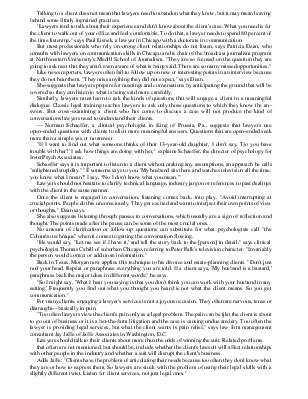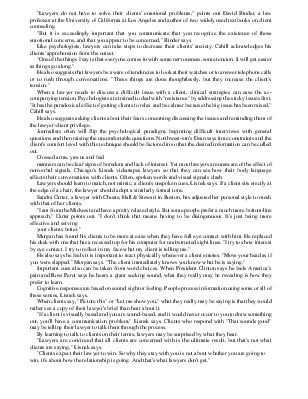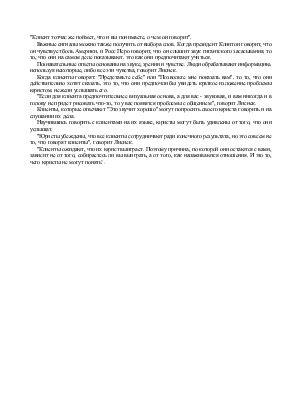




Talking to a client does not mean that lawyers need to abandon what they know, but it may mean leaving behind some firmly ingrained practices.
"Lawyers tend to talk about their experience and don't know about the client's case. What you need is for the client to walk out of your office and feel comfortable. To do that, a lawyer needs to spend 80 percent of the time listening," says Paul Lisnek, a lawyer in Chicago with a doctorate in communication.
But most professionals who rely on strong client relationships do not listen, says Patricia Dean, who consults with lawyers on communication skills in Chicago and is chair of the broadcast journalism program at Northwestern University's Medill School of Journalism. "They are so focused on the question they are going to ask next that they aren't even aware of what is being said. There are so many missed opportunities."
Like news reporters, lawyers often fail to follow up on new or interesting points in an interview because they do not hear them. "They miss anything they did not expect," says Dean.
She-suggests that lawyers prepare for meetings and conversations by anticipating the ground that will be covered so they can listen to what is being said more carefully.
Similarly, lawyers must learn to ask the kinds of questions that will engage a client in a meaningful dialogue. Classic legal training teaches lawyers to ask only those questions to which they know the answers. But cross-examining a client who has come to discuss a case will not produce the kind of conversations lawyers need to understand their clients.
— Norman Schaeffer, a clinical psychologist in King of Prussia, Pa., suggests that lawyers use open-ended questions with clients to elicit more meaningful answers. Questions that are open-ended seek more than a simple yes or no answer.
"If I want to find out what someone thinks of their 13-year-old daughter, I don't say, T)o you have trouble with her?' I ask how things are doing with her," explains Schaeffer, the director of psychology for In-terPsych Associates.
Schaeffer says it is important to listen to a client without making any assumptions, an approach he calls "enlightened stupidity." "If someone says to you, 'My husband sits there and watches television all the time, you know what I mean?' I say, *No I don't know what you mean.'"
Lawyers should not hesitate to clarify technical language, industry jargon or references to past dealings with the client in the same manner.
Once the client is engaged in conversation, listening comes back, into play. "Avoid interrupting at crucial points. People do this unconsciously. They get excited and want to interject their own points of view or thoughts," Dean says.
She also suggests listening through pauses in conversations, which usually are a sign of reflection and thought. The points made after the pause can be some of the most crucial ones.
No amount of clarification or follow-up questions can substitute for what psychologists call "the Columbo technique" when it comes to getting the conversation flowing.
"He would say, "Let me see if I have it,' and tell the story back to the [person] in detail," says clinical psychologist Thomas Cahill of suburban Chicago, referring to Peter Falk's television character. "Invariably the person would correct or add more information."
Back in Texas, Morgan now applies this technique to his divorce and estate-planning clients. "Don't just nod your head. Repeat or paraphrase everything you are told. If a client says, 'My husband is a bastard,' paraphrase back the major ideas in different words;" he says.
"So I might say, 'What I hear you saying is that you don't think you can work with your husband in any setting.' Frequently you find out what you thought you heard is not what the client means. So you get communication."
For many clients, engaging a lawyer's services is not a joyous occasion. They often are nervous, tense or distraught—basically in pain.
"Too often lawyers view the client's pain only as a/legal problem. The pain can be tjlat the client is about to go out of business or it is a bet-the-farm litigation and the case is causing undue anxiety. Too often the lawyer is providing legal services, but what the client wants is pain relief," says law firm management consultant Jay Jaffe of Jaffe Associates in Washington, D.C.
Lawyers should talk to their clients about more than the odds of winning the suit. Related problems
that often are not mentioned, but should be, include whether the client's lawsuit will affect relationships with other people in the industry and whether a suit will disrupt the client's business.
Adds Jaffe: "Clients have the problem of articulating their needs because too often they don't know what they are or how to express them. So lawyers are stuck with the problem of using their legal skills with a slightly different twist. Listen for client services, not just legal ones."
"Lawyers do not have to solve their clients' emotional problems," points out David Binder, a law professor at the University of California at Los Angeles and author of two widely used textbooks on client counseling.
"But it is exceedingly important that you communicate that you recognize the existence of those emotional concerns, and that you appear to be concerned," Binder says.
Like psychologists, lawyers can take steps to decrease their clients' anxiety. Cahill acknowledges his clients' apprehension from the outset.
"One of the things I say is that everyone comes in with some nervousness, some tension. It will get easier as things go along."
He also suggests that lawyers be aware of tendencies to look at their watches or to answer telephone calls or to rush through conversations. "These things are done thoughtlessly, but they increase the client's tension."
When a lawyer needs to discuss a difficult issue with a client, clinical strategies can ease the accompanying tension. Psychologists are trained to deal with "resistance" by addressing the sticky issues first. "It has the paradoxical effect of getting clients to relax and be calmer because the big issue has been raised," Cahill says.
He also suggests asking clients about their fears concerning discussing the issues and reminding them of the lawyer-client privilege.
Уважаемый посетитель!
Чтобы распечатать файл, скачайте его (в формате Word).
Ссылка на скачивание - внизу страницы.